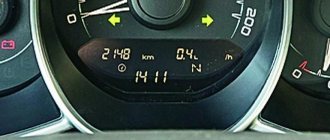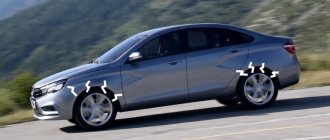Enough time has passed since the launch of mass production to objectively consider all the shortcomings of the Lada Vesta. Although it’s worth starting with the fact that in many ways AvtoVAZ’s new product met consumer expectations:
- good handling for cars of this class;
- roomy trunk and spacious interior (if we compare Vesta with competitors such as Solaris and Rio);
- decent security system;
- stylish appearance;
- many useful standard options implemented by the plant for the first time.
But even the leaders of the global automobile industry do not have ideal cars - there are always pros and cons, and the latter often arouse more interest.
Lada Vesta
Disadvantages of the interior
The new Lada Vesta at first does not raise any questions about the interior, but over time some assembly problems may appear. Most often, these are crickets and creaking parts - a clear sign that the manufacturer has saved on seals. The steering wheel cover also leaves much to be desired - the paint wears off very quickly.
The disadvantages of the Lada Vesta's interior are complemented by the low quality of plastic: the parts are hard and look cheap. Although the owners say that such material is more convenient to wipe off dust.
Putting aside complaints about materials, you need to pay attention to the weak points of the dashboard: poor data readability, some additional indicators are too small, and the view of the upper part of the instruments is partially obscured by the edge of the “well” and the steering wheel.
Dashboard
But the comfort of the Lada Vesta can be classified more as an “advantage”, but this is if you close your eyes to the awkward driver’s armrest and the lack of it for the front passenger.
Cons: problems with the oil pump
This problem began to appear as soon as Vesta received a new VAZ 1.8-liter power unit 21179. A feature of this engine is the presence of a phase shifter, the operation of which required an oil pump with improved performance indicators. The pump itself may be reliable, but its pressure relief valve is its weak point.
There have been a lot of reviews describing this problem on the Internet, so now we can summarize the manifestation and elimination of the defect. It all starts with the oil pressure indicator coming on when the car is idling. When you contact the dealer service, they try to clean the pressure relief valve, but this rarely helps. As a result, under warranty, the pump paired with the crankshaft, liners, and also the cylinder head is replaced, and all this takes a long time. The manufacturer itself assures that such cases are not widespread and apply to cars of any brand, and the issue is resolved within the framework of warranty obligations. Lately people have started writing about the problem less and less: apparently AvtoVAZ has improved the problematic component.
AMT robotic transmission
The assessment of an auto expert or the opinion of an ordinary driver will certainly affect the transmission that is not the most successful. The new “robot” produced by VAZ is, in fact, a modernized manual transmission VAZ-2108. And these boxes have always had the problem of oil starvation of the upper shafts. In addition, the Lada Vesta is deprived of the oil level in the transmission.
The car's shortcomings also manifest themselves in increased wear of synchronizers, which has always been characteristic of gearboxes of this series.
The AMT has a clutch from Valeo. Despite the quality, it can fail after 80 thousand km, and replacing it is not a cheap pleasure.
Many drivers of the Lada Vesta complain about such problems as failures when changing gears and a delayed transition to second gear. So on your first trips it is very likely that you will experience negative emotions when accelerating.
But the robotic transmission is not hopeless and, in terms of settings, is comparable to expensive cars. And with a “traditional” automatic, fuel consumption would be less economical.
pros
1. Options and prices.
Lada Vesta is more profitable than its competitors (see comparison with Hyundai Solaris) and to this day storms the top positions of top sales (see AEB sales statistics).
2. Controllability and stability
. There was good feedback in the steering wheel (see reviews from stuntmen), and the suspension had healthy elasticity and energy intensity.
3. Beautiful and spacious interior
. Comfortable driving position, more leg and shoulder room for the right passenger. Rear passengers have plenty of headroom. The interior design did not disappoint either (see interior dimensions).
4. Dimensions.
With body dimensions of 4,410 / 1,764 / 1,497 mm, Vesta belongs to class B+ and, being one of its largest representatives, gravitates towards the higher C-class. And the Vesta platform itself was made with an eye toward designing C-class cars.
5. Appearance
. For the first time in a long time, the words “beautiful” and “Lada” can be used one after another without the risk of falling under a hail of condescending laughter.
Rapid contamination
There is too much clearance in the hood latch area, allowing dirt and water to enter the engine from the outside. As a result, Vesta owners are forced to resort to cleaning the engine compartment more often and installing various seals.
Large gaps in the housing
Large gaps in the housing
Rapid contamination is also typical for the body. Most likely, the reason is the large wheel arches, and the X-shaped imprints also play a role in collecting dirt. In addition, the lack of edges on the windshield affects it and, as a result, the side windows quickly become clogged.
Another drawback of the Lada Vesta is associated with the side windows - very poorly selected seals. Because of them, dirt gets inside the door, which subsequently leads to scratches.
It is also worth remembering ineffective windshield wipers, which some car owners change without hesitation. Standard wipers not only fail to do their job, but also begin to leave scratches over time.
Body corrosion resistance
The owners can still say little about the corrosion resistance of the body, since they have not been using the car for a long time. But the Autoreview publication conducted a fairly serious test during which the car was placed in a salt chamber - in the chamber the car corrodes faster. Calibrated notches were applied to the body.
It turned out: Vesta resists corrosion quite well. During the experiment, it turned out that the roof is less protected and quickly begins to rust.
The roof is a non-damageable element in a car, and apparently this is why AvtoVAZ went for cheaper technology. Otherwise, Vesta should not rot for a long time, as old domestic cars did.
And on little things...
Some of the disadvantages of the Lada Vesta listed below can be attributed to nit-picking and not to serious shortcomings, but they still exist and create inconvenience for car owners:
- narrow pedal assembly;
- insufficient rear visibility;
- frequent malfunctions of the heated windshield;
- excessive sensitivity of ABS fails;
- no lock on the gas tank cap
- Incomprehensible operation of the central locking.
In general, eliminating factory defects for AvtoVAZ is one of the priority tasks in the policy of improving product quality. It is important for consumers to contact their personal managers in a timely manner not only with serious problems, but also with minor defects, thus making their contribution to the elimination of factory defects by the plant.
Weaknesses of Lada Vesta
Lada Vesta has been produced at AvtoVAZ facilities since November 2015. The article selects all the weaknesses of Vesta that have been identified by car owners at the moment. The line of power units consists of three gasoline engines: 11189, 21129, HR16DE-H4M. The latter is an imported engine produced by the Renault-Nissan alliance. It is installed on such Nissan car models as: Note, Qashqai, Juke, Tiida. The total share of Russian-made spare parts is 20%. Reviews from West owners speak positively about the car, but there are still some shortcomings that may await you soon after purchase and active use.
Our infographics contain the most current and most common Vesta diseases, so this information will help owners of the new model prepare for possible problems and find out the weak points of the Lada Vesta.
Chassis:
A very common problem is weak stabilizer links . The problem was noticed on the first Lada Vesta. Literally after 3 thousand kilometers they begin to tap. There is also the creaking of stabilizer rubber bands on smooth metal when moving over bumps. The creaking is eliminated under warranty by sanding the smooth surface of the metal with sandpaper. AvtoVAZ argues this problem is a bad supplier, which has already been replaced by a supplier of better quality racks.
At a mileage of 30 thousand km, play may appear in the lower bearings of the steering knuckle . Subsequently, AvtoVAZ eliminated the play of the ball joint by changing the liner housing, which also simultaneously solved the problem of squeaks when turning the wheels.
Factory alloy wheels are so weak that they bend when the wheel gets into even a small hole, which is why you can often hear them called “paper”.
Transmission:
Errors in the automatic transmission algorithm , the automatic transmission can be thoughtful at times, and “nodding” occurs when changing gears. The reason for this is a glitch in the first firmware. It can be solved by reflashing it from an official dealer. As for the manual transmission, the situation is better; only on some of the first Vestas with manual transmission do difficulties appear in shifting gears .
After 15,000 km, on some manual gearboxes from Renault (JH3), the bearing began to howl, and 1st, 2nd and 3rd gears were difficult to engage (the rod blocking block stuck in its hole).
Salon:
Cricket behind the instrument panel . It can be eliminated quite easily by removing the panel and installing sealing materials under the creaking plastic.
The paint on the steering wheel lining wears off quickly . Moreover, even after a warranty replacement, abrasions quickly appear.
At 4th or 5th speed of the heater fan, vibration appears on the steering wheel . This is due to contamination of the impeller. By the way, in the cars of 2021, this problem was not solved in Vesta.
The trim on the rear doors is coming off .
There is a knocking sound from the cables under the side door trim. It can also be easily removed by fixing them. All these problems concern the first releases of Vesta; most likely, they will be corrected in the future, because as practice shows, AvtoVAZ reacts quite quickly to emerging childhood problems.
Electronics:
Multimedia glitches , there are many complaints that when AUX mode is running on the multimedia system, a black screen appears when the rear view camera is turned on. Or the multimedia does not start at all unless you do a hard reset. Most likely this is also a temporary problem with the first machines, which will be eliminated with new firmware.
There are also cases of the heated windshield not working. Possible reasons: either the firmware or the fuse (there are two of them).
The ignition coil was noticed to fail (on cars from the first batch), it was replaced under warranty.
Door limit switches begin to fail at 20 thousand mileage.
Body:
When driving around 3 thousand km, when using standard frame wipers, scratches appear on the windshield . Here it’s like on old VAZs - “buy a new car and immediately change the wipers.” The case is under warranty and the official dealer will replace the glass.
The front and rear bumpers suffer greatly from chips and scratches, and the paint on it begins to peel off along with the varnish.
Another common drawback of Vesta is that the velvet covers fit too tightly to the side windows. If sand gets in and you still use the power windows, scratches will form on the side windows , the appearance of which is accompanied by a squeaking sound. The official instructions from AvtoVAZ in this case are to cut off two sides of the seal.
There have been cases of dirt accumulating under the hood due to the absence of a section of the hood seal in the lock area . Dirt not only spoils the appearance, but is also harmful to engine compartment devices, such as the generator, belts, electricians, and the like. This problem is relevant for the Lada Vesta of the first releases. Can be cured by installing another seal.
And after six months of operation, the door hinges may begin to creak, naturally, after lubrication everything goes away, but the very fact that the factory lubrication is not enough for a long time is a little upsetting.
Headlights:
The headlights themselves are fine, but for some reason the turn signals on the side rearview mirrors
Exhaust system:
After 30 thousand km, the rubber bands securing the muffler begin to sag and these “carrots” simply break.
Breaking off of brackets on the exhaust exhaust pipe - steel nuts were used instead of brass.
What changes have taken place in Vesta cars of 2021 and 2021?
These are, in principle, all the problems that a car can suffer from. Yes, it is damp and expensive when compared with Rio and its other Korean brother Solaris, but they also had many shortcomings in their time, which, by the way, the manufacturer was in no hurry to eliminate. But no one could imagine that a new VAZ car would have only a couple of “childhood diseases”, each of which can be easily and inexpensively eliminated.
Summary
To summarize, we can say that despite the minor shortcomings of the Lada Vesta, the car as a whole turned out great. There is good handling, excellent design, good ergonomics and a good landing, in which severe fatigue is not noticed even on long trips. Most likely, the identified problems with the Lada Vesta will be eliminated in the future. After all, each car produced has a personal manager attached to it. If you contact him, a technical inspection will be promptly organized by an official dealer. Each detected case of Vesta malfunction is documented, then data on the breakdown is sent to the manufacturer for elimination in subsequent production. The car is new in every sense of the word, so the article will be updated as new problems arise. You can help us make this article better. Leave any problems you notice with the Lada Vesta in the comments.
Exhaust system
Lada Vesta inherited from the VAZ-2108 and 2109 the “disease” of the exhaust system - sagging rubber bands on the muffler mounts. Owners of domestic cars claim that after 30 thousand kilometers you can hear the characteristic sound of the muffler beating against the tunnel - a sure sign of wear on the rubber elements. In rare cases, the exhaust system resonator burns out - a lifespan of about 80,000 kilometers. You can often hear from drivers how the noise of the Lada Vesta exhaust system interferes with driving. Official representatives of AvtoVAZ even gave clarifications on this matter. The thing is that both at high and low speeds, a hum, whistle and other unpleasant sounds from the muffler may appear. It may seem that the corrugation simply does not suppress the resulting vibrations. To which AvtoVAZ responded that the noise of the exhaust system is a problem for a specific car. If you encounter a similar problem, then you need to contact the dealership, where the dealer is required to fix the “jambs” under warranty.











